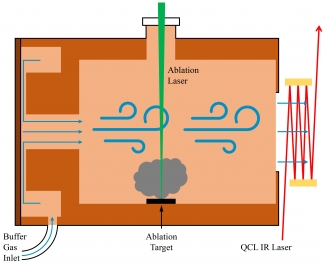A Cryogenic Buffer-Gas Beam (CBGB) consists of a cold, inert gas (such as neon or helium) flowing in a specific direction (often through a CBGB cell), with some species of interest entrained in the flowing gas. Many species of interest (such as reactive molecules, clusters, etc.) do not remain gaseous at the temperatures desirable for further scientific study (~4 – 30 K). However, if these species are entrained in a flowing, inert gas that can be held at these temperatures, the species of interest can be cooled to these low temperatures and still remain in the gas phase for further study. In our lab, we are working on producing carbon clusters and metal oxide clusters, produced via laser ablation of a solid target and then cooled to ~25 K in a neon buffer gas beam. These types of clusters have relevance to many different fields of research, including astronomical and interstellar physics and chemistry, combustion chemistry and soot formation, and catalysis, just to name a few.



 The Physics Frontiers Centers (PFC) program supports university-based centers and institutes where the collective efforts of a larger group of individuals can enable transformational advances in the most promising research areas. The program is designed to foster major breakthroughs at the intellectual frontiers of physics by providing needed resources such as combinations of talents, skills, disciplines, and/or specialized infrastructure, not usually available to individual investigators or small groups, in an environment in which the collective efforts of the larger group can be shown to be seminal to promoting significant progress in the science and the education of students. PFCs also include creative, substantive activities aimed at enhancing education, broadening participation of traditionally underrepresented groups, and outreach to the scientific community and general public.
The Physics Frontiers Centers (PFC) program supports university-based centers and institutes where the collective efforts of a larger group of individuals can enable transformational advances in the most promising research areas. The program is designed to foster major breakthroughs at the intellectual frontiers of physics by providing needed resources such as combinations of talents, skills, disciplines, and/or specialized infrastructure, not usually available to individual investigators or small groups, in an environment in which the collective efforts of the larger group can be shown to be seminal to promoting significant progress in the science and the education of students. PFCs also include creative, substantive activities aimed at enhancing education, broadening participation of traditionally underrepresented groups, and outreach to the scientific community and general public.